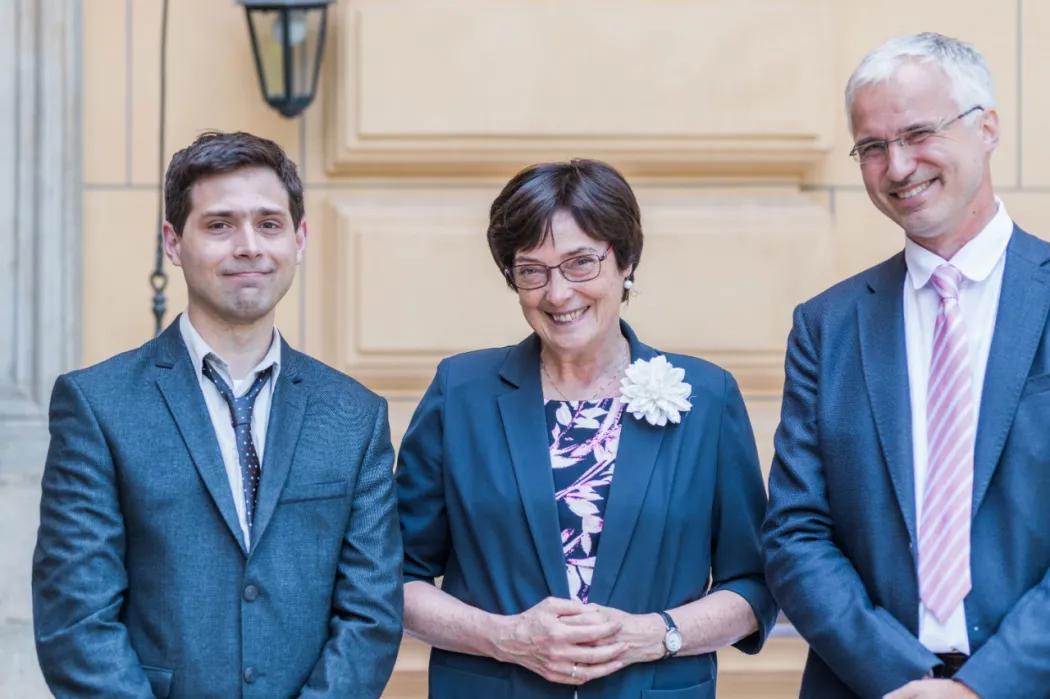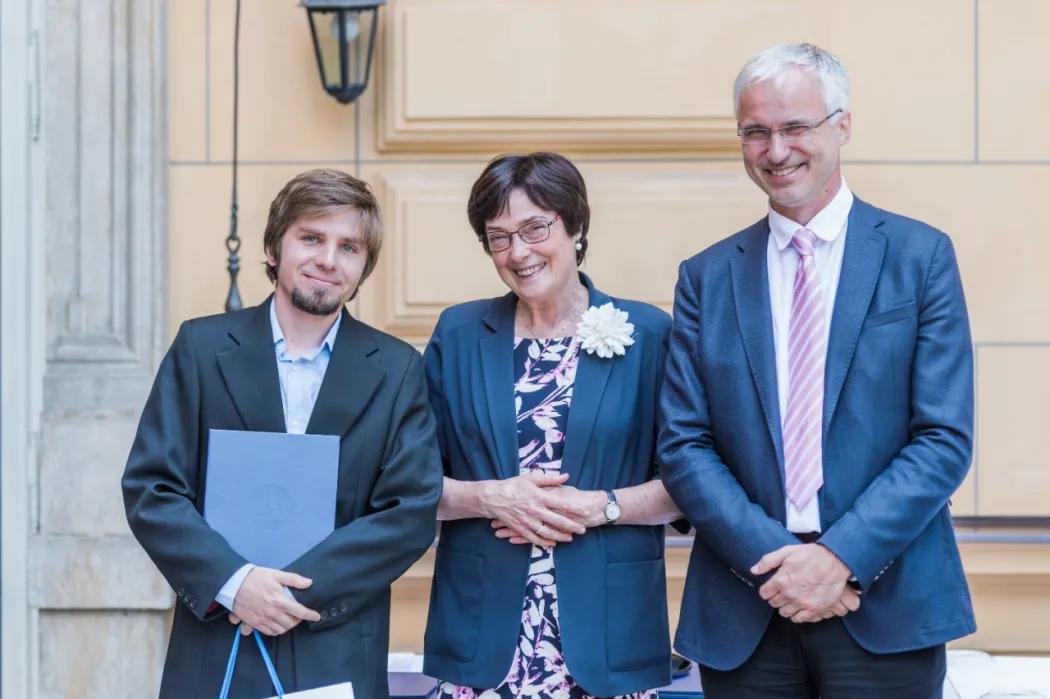Eva Zažímalová, the President of the Czech Academy of Sciences, has given the Otto Wichterle Award to twenty two young scientists in villa Lanna in Prague. Four of them were from the Institute of Physics of the Czech Academy of Sciences – Mgr. Jan Ebr, Ph.D., RNDr. Hana Lísalová, Ph.D., Mgr. Oleksandr Stetsovych, PhD and Ing. Jakub Železný, PhD.
The Otto Wichterle Award is a prestigious honour coming with a financial reward which has been awarded to excellent young scientists by the Czech Academy of Sciences since 2002. It can be awarded to scientists working at the Czech Academy of Sciences who have a post-gradual degree and are not older than 35. The award bears the name of a renowned physicist, Otto Wichterle, who is well-known mainly for the invention of contact lenses.
Jan Ebr
In his scientific work, Mgr. Jan Ebr, Ph.D., focuses on models of hadron interactions. He was the first one to connect the surplus of muons in the data of cosmic radiation of low energies observed by a phenomenological approach with the observation of the muon surplus at highest energies of primary particles at the Pierre Auger Observatory in Argentina. He presented his research at international conferences and published papers in renowned reviewed journals.
The second area of J. Ebr’s activities is the study of atmospheric conditions at astroparticle observatories. At the moment, FRAM telescopes are installed at the Pierre Auger Observatory and the location of the future CTA Observatory. Another such device is being tested at the Institute of Physics of the Czech Academy of Sciences in Prague and another one is in production. Most recently, he and his colleagues have managed to prove the satisfactory accuracy of this method for the needs of CTA Observatory. In comparison with LIDAR systems, a big advantage of FRAM telescopes is that observation does not affect the detection of showers of cosmic radiations in any way.
Hana Lísalová
Hana Lísalová focuses on the research and development of optic biosensors and functional surfaces. She has achieved international success and has gained respect in the scientific community worldwide. She has published tens of articles in top-class professional journals (e.g. Analytical Chemistry, Biosensors and Bioelectronics, Nucleic Acids Research, Biomaterials, etc.).
Hana Lísalová is also an author of three chapters in books and has initiated five patent applications to be submitted, out of which three patents have already been granted. She gives regular lectures at international prestigious conferences in the respective field (Europtrode, OSA Advanced Photonics Congress). In the period 2013–2017 she worked at the Institute of Photonics and Electronics of the Czech Academy of Sciences, since November 2017 she has been further developing her scientific work at the Institute of Physics of the Czech Academy of Sciences, where at the moment she is building a new research team focused on research of functional surfaces and their interaction with biomolecular systems. Hana Lísalová successfully supervises theses of students in Master and PhD studies and she actively participates in the popularisation of scientific work.
Oleksandr Stetsovych
Mgr. Olexandr Stetsovych, Ph.D., is a recognized expert in the area of scanning electron microscopes and he is a co-author of a number of significant works which were published in top-class scientific journals (Nature Chemistry, Nature Communications). His work contributed not only to the development of scanning electron microscopes but also to a deeper understanding of material characteristics of surfaces and nanostructures. He significantly participated in works about new possibilities of molecular nanostructures and solid particle surfaces imagining by means of scanning electron microscopes.
Apart from other things, he also proved the existence of a piezoelectric effect on individual molecules by means of scanning probe microscopy. At present, he intensively investigates the possibility to use the piezoelectric effect in nanotechnologies. It is exactly proving the piezoelectric effect on the level of individual molecules which is one of the key prerequisites for its application in molecular electronics that remained a challenge for scientists for a long time. This breakthrough will enable a new concept of design of future molecular devices, such as engines, sensors and electric power generators on the level on nanometres.
Jakub Železný
Only two years after obtaining his PhD degree, Ing. Jakub Železný, Ph.D., has achieved extraordinary scientific success. In 2014 he published as the first author a theoretical prediction of a phenomenon which enables electric recording of information in antiferromagnetic memory. In 2016, he explained the first experimental observation of this phenomenon by using microscopic calculations. These works, which currently have over 200 citations, has opened a new branch of so-called antiferromagnetic spintronics. The impact of the work is evidenced also by publishing a special issue of Nature Physics journal in March 2018. Jakub Železný participated in this special issue as the first author of a summary article about electronic recording and reading of information in antiferromagnetic memories.
From the initial model calculations, Jakub Železný has quickly moved to microscopic simulations by means of the state-of-art ab initio methods. He mastered these methods during his several months’ stay in Forschungszentrum Jülich in Germany which is a world-recognized centre for ab initio calculations of transport phenomena in solid matter. After defending his PhD thesis, Jakud Železný was offered a post-doctoral placement in the Max Planck Institute for Chemical Physics of Solids in Dresden, which specializes in research in materials. Jakub Železný caught the attention of the Max Planck Institute management to such an extent that they supported his obtaining the prestigious Max Planck Partner Group Grant. This programme supports young scientists in establishing their own scientific groups at new workplaces and continuing collaboration with the Max Planck Institute. Jakub Železný will use the grant awarded to establish a group of spintronic ab initio calculations at the Department of Spintronics and Nanoelectronics of the Institute of Physics of the Czech Academy of Sciences. His group will be, along with other things, crucial for the successful solution of a newly awarded European project ASPIN, which is coordinated by the Institute of Physics and apart from three institutes of Max Planck also other partners from Germany, UK and Spain participate in it.


